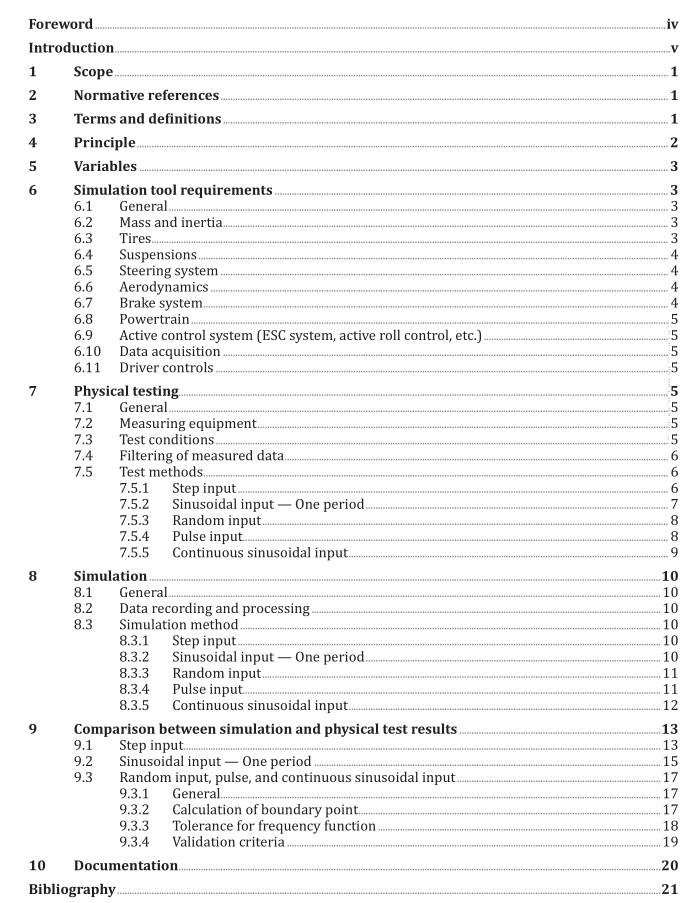ISO 22140 pdf download

ISO 22140 pdf download Passenger cars — Validation of vehicle dynamics simulation — Lateral transient response test methods
Large lateral slip angles and camber angles can occur under the conditions covered in this document. The tire model shall cover the entire range of slip (lateral and longitudinal), inclination angle relative to the ground, and load that occur in the tests being simulated. The tire lateral force reduction at high slip angles is a critical characteristic that shall be comprehended by the tire testing and modelling.
The effect of combined tire lateral and longitudinal slip on forces and moments shall also be modelled. The surface friction coefficient between the tire and ground is an important property for the limit friction conditions that can be encountered in tests. The simulated tests take place on a flat homogenous surface; detailed tire models that handle uneven surfaces are not needed. If the test surface has inclination for water drainage, this should be included in the simulation.
6.4 Suspensions The properties of the suspensions that determine how the tire is geometrically located, oriented, and loaded against the ground shall be represented properly in order for the tire model to generate the correct tire forces and moments. The suspension properties also determine how active and reactive forces and moments from the tires are transferred to the sprung mass. The suspension properties should include change of location and orientation of the wheel due to suspension vertical deflection, steering, and compliance due to applied load as would be measured in a physical system in kinematics and compliance (K&C) tests. The model shall cover the full nonlinear range encountered in the tests for springs, jounce and rebound bumpers, and auxiliary roll moments due to anti-roll bars and other sources of roll stiffness. Rate-dependent forces such as shock absorbers are significant and shall cover the range of suspension jounce and rebound rate encountered in the tests.
6.5 Steering system The steering system interacts with the suspensions to determine how the tire is oriented on the ground. The test requires that either a robot or driver provides steering wheel control. The model should include kinematical and compliance relationships needed to calculate the road wheel angles from the steering- wheel angle. The model should include the effects of active control systems, if applicable in the test. If a robot controller provides the steering, the model does not need to predict the associated steering- wheel torque for this document. However, it should be recognized that inadequate steering robot torque capacity can result in steering inputs that do not match the intended angle. This can be a source of discrepancy between simulation and test results.
6.6 Aerodynamics The model should include aerodynamic effects that influence tire load and overall vehicle drag for speeds up to 120 km/h.
6.7 Brake system If the brakes are not engaged during the testing, then the brake system is not needed. However, if an active controller engages that uses the brakes to control the vehicle during the test covered in this document (see 6.9), then the vehicle brake model shall include the actuators and response properties that affect the controlled vehicle response.
6.8 Powertrain In the open-loop steering manoeuvre covered in this document, the standard speed is 100 km/h, and other test speeds of interest may be used (preferably in 20 km/h steps). The model should include the drag on the driven wheels, as needed to replicate this behaviour. Inertial effects that influence the wheel spin dynamics during any intervention by active control system shall be included. Other aspects of powertrain behaviour that are important for other kinds of tests (engine power, dynamic responses to throttle, shifting and clutch behaviour) are probably not needed for constant speed of the tests; however, if a chassis control system engages, then any aspects of the powertrain that influence the controller behaviour shall be included in the powertrain model.









